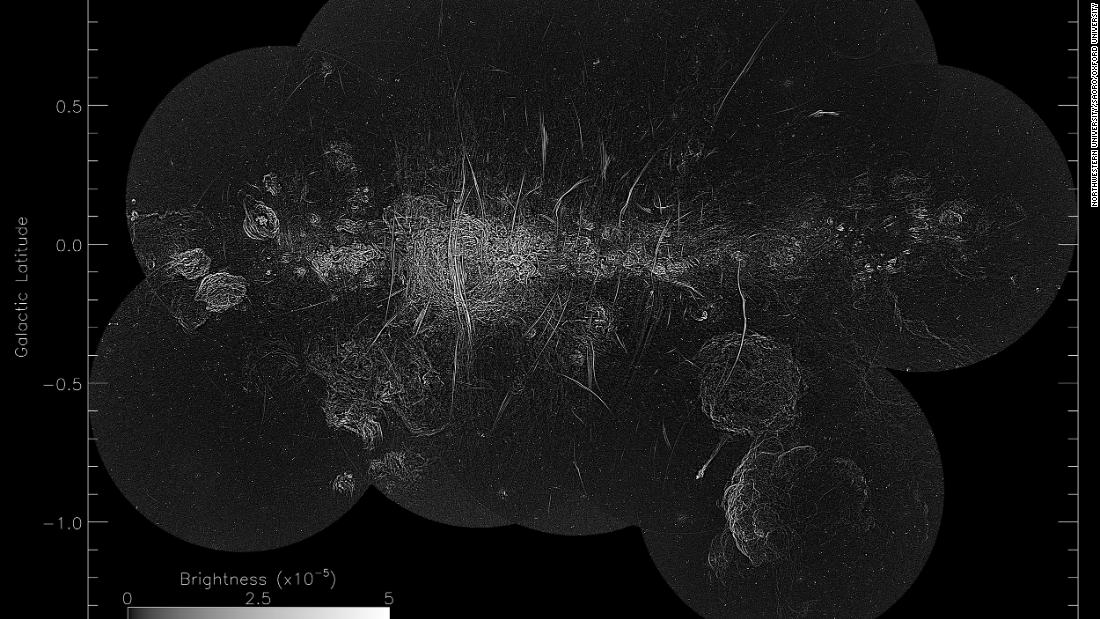(CNN) – The center of our galaxy, the Milky Way, has many intriguing features, including nearly a thousand mysterious magnetic texts, according to a new telescope image.
The pairs and groups of fibers are approximately 150 light-years long and are evenly spaced.
Strange structures are a few million years old and vary in appearance. Some of them resemble lute strings, waterfalls or rings around Saturn.
But the true nature of the fibers remains elusive.
Farhat Youssef-Sade, a professor of physics and astronomy at Northwestern University, first discovered fibers through radio waves 35 years ago. He determined that the filaments were formed by cosmic ray electrons moving their magnetic fields at the speed of light. However, the origin of these texts remains a mystery.
Now, using the South African Radio Astronomical Observatory’s MeerKAT telescope, astronomers are able to find 10 times more texts than Youssef-Zadeh’s previous discoveries.
A study describing these findings was accepted for publication in The Astrophysical Journal Letters.
Youssef-Zadeh, lead author of the study and a member of the Northwest Center for Astronomical Research and Research, said in a statement that “we have long studied individual fibers with myopic vision.”
“Now, we finally see the big picture: the sight of a bird full of lots of fibers. Looking at a few strands makes it difficult to make a real decision about what they are and where they came from. This is a turning point for a promotion.” Our understanding of these structures.
This mosaic image of the center of the Milky Way reveals mysterious magnetic fibers in the form of large vertical bars.
Looking at the far center of the Milky Way, which is 25,000 light-years away from Earth, the new detailed picture is actually created by a mosaic of 20 different observations taken over three years.
In addition to the long strands, the image shows star birth signatures and remnants of stars erupted by radio emissions. Youssef-Zadeh and his research team focused only on the threads and isolated them from other events captured in the film.
“It’s like modern art,” he said. “These pictures are so beautiful and rich, and the mystery of it makes it even more interesting.”
Separates the fibers
The amount of radiation differs from other energetic cosmic phenomena such as supernova remnants, as analyzed by the group’s texts. Scientists believe it is more related to past activity caused by the larger black hole in the center of the Milky Way than the eruption of galaxies.
The panel also determined that the magnetic fields are strong with fibers.
Studying a large group of fibers allows scientists to better understand them, although there are many mysteries.
“For example, if you belong to another planet and you have met the tallest person on earth, you can assume that all people are taller,” Youssef-Zadeh said. “But if you do population statistics, you can find the average height. That’s what we do. We can find the strength of magnetic fields, their length, their orientations and the radiation spectrum.”
As the team works to identify each thread, they are still trying to figure out whether the threads are sorted and equidistant between the groups, the acceleration of the particles or whether the threads move over time.
“Every time we answer a question, many questions arise,” Yusuf-Saadeh said. “How do electrons accelerate near the speed of light? One theory is that there is some evidence that these particles accelerate at the ends of the strands.”
In 2019 the threads could be combined with the previous invention of Youssef-Zadeh and his team: Structures Giant balloons In the heart of the galaxy.
Many studies on fibers will be published in the future, and scientists hope to find out how they fit together in the complex of materials near the center of the Milky Way.
“We hope to get to the bottom, but more observations and theoretical analysis are needed,” he said. “A thorough understanding of complex materials takes time.”


:quality(85)/cloudfront-us-east-1.images.arcpublishing.com/infobae/SMPW7M5BQFERBOQUPJXKCOKARY.jpg)
:quality(85)/cloudfront-us-east-1.images.arcpublishing.com/infobae/NP5NEZXMZFGNLBHNEQJHPJVMKM.jpg)

:quality(85)/cloudfront-us-east-1.images.arcpublishing.com/infobae/X7DZAL3I4REJTKPZ4Y4DYBHFMI.jpg)